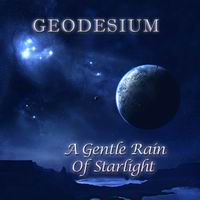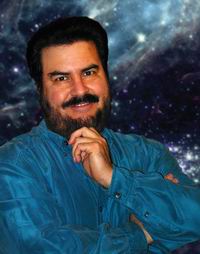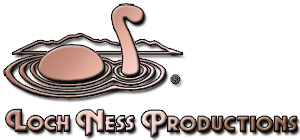

A Gentle Rain Of Starlight
Fall in love with the stars all over again!
What music would you listen to while exploring the starry winter sky, enjoying the solitude of a star-filled night, drifting through space across lagoons of silver light, and having a romantic interlude under a distant sun? All these soundscapes, and more, await the listener on A Gentle Rain of Starlight, Mark Petersen's 2007 Geodesium album release. These 13 evocative sound journeys were created for the rarefied atmosphere of the planetarium dome. Now, they soar free as soulful explorations of the stars.
As with many of the other albums in the Geodesium series, the impetus for the creation of A Gentle Rain Of Starlight came from the production of a planetarium show soundtrack. Mark's task this time around was to create soundscapes for a series of shows that are the bread-and-butter of planetarium fare: constellation identification presentations, commonly called "star talks." Typically these shows are about night-sky viewing from the familiar confines of the average back yard, and what anyone can see by stepping outside on a clear, dark night.
The simplicity and directness of these programs' themes provided a specific direction for Mark. "In these shows, we're always 'at home'; we didn't leave planet Earth. We're simply looking up from familiar landscapes," he mused. "That meant the space music had to be familiar-sounding too, and needed to contain 'links' to planet Earth through what it portrays."
So Mark stayed 'terrestrial' by exploring some very tonal and harmonically approachable sound spaces. In the process, a few compositions developed into themes that were too strong to be used as the kind of 'background wallpaper' needed for narration beds, but they work well for listening on their own. Eventually, he decided on an overall 'everything in the key of F' scheme for the show music. He did create other tracks, mostly in minor keys; they appear exclusively on this album.
Since the shows had no alien vistas to visit, there wasn't much call for atonality or strangeness. Mark took recognizable chordal structures in overt major and minor progressions, and spun them with the wafty, floaty, and sometimes atemporal stylings of electronic music to create his unique 'space music with hooks' that a reviewer once coined for the Geodesium sound. No drums here to clash with the narrative — both in the show and in the listener's mind. But with the extensive use of the Korg Karma keyboard, there's no shortage of rhythmic expression in this music to take listeners to unexpected places.
As with much of electronic music, the technology available to the artist can shape the structure and direction of the music in very fundamental ways. For the works on this album, Mark took advantage of the "generated effects" capability inherent in the Korg Karma — or what some have deemed its 'arpeggiator-on-steroids' capability. While it can get way too frantic if not used properly, Mark deftly harnessed its glissandos and swoops to create dramatic and beautiful effects.
"It provides such rich textures, instantly, that would have taken hours to create in the olden days," he said. "But, as with much of my life, what I do is off the bell curve. It's rather unfortunate for me that so many of the Karma's internal programs and combinations were designed for making dance and hip-hop music. Those are just about the antithesis of what I needed to do for this album. You step through some of the Karma presets, touch one key, and pounding drums and bass come blasting out at full volume. It gets to be quite annoying, actually."
Earlier in his composing career, Mark reminisced, he would have spent days and weeks honing his own adjustments to presets and synth sounds, and programming new ones of his own. "It seems like these days, I don't have the time or maybe the patience to devote to doing that," he said. "Yet I don't think I've fallen into the trap of having 'cookie-cutter' sounds and clips. I feel that what I do manage to come up with doesn't sound too much like 'everyone else' and their approaches."
To explain his individuation from the crowd, Mark talked about the similar way in which visual artists separate themselves from the crowd, even though they may use similar (or identical) tools to create their art. "I attended a visual artists gathering a while back, when many discussions involved grappling with the transition from analog to digital methods of painting," he said. "The consensus was that an artist's individual style remained constant and recognizable, no matter what tools were used in the creation. The digital works are often more intricate and developed, but you can easily recognize familiar elements from an artist's palette. It's the same in music; you recognize Tangerine Dream's sound after a few bars, even though these days the music could be coming from computers instead of walls of synthesizers with patch cords. I hope listeners will be right at home with this new album, and understand the use of new tools to create my kinds of sounds."
To be sure, fans accustomed to previous Geodesium discs should recognize the sounds and melodic riffs that he has carried from album to album. These help form the hallmark of the Geodesium style.
If there's a 'formula piece' that opens a Geodesium album, it's Winter Stars, a work that hearkens back to The Grand Tour from West of the Galaxy. In another universe, with another musician, it would probably have lyrics. Mark remembers an old friend once reminded him that "careful listeners should be rewarded." In the planetarium show, the filtered wash of chordal sound that wafts throughout rises and falls with the narration, which takes the viewer on an exploration of the stars around the constellation Orion. Outside the confines of a narrated presentation, Winter Stars introduces the listener to a private, wordless tour of the sky.
Constellation spotting lets you hop from star to star, drawing imaginary lines between them, like a giant celestial game of connect-the-dots. For Star Hop, Mark took the hopping part literally and created a piece that bounces across the heavens and through your musical consciousness.
If you've ever wondered what drops of starlight rain would sound like, the title track A Gentle Rain Of Starlight takes you to that sound space. Mark credits Carolyn for suggesting the title; it comes from a book of the same name by astronomer Michael West. The gentle, evocative imagery the words create in your mind is a perfect match for this piece. Mark created music that is stately and almost serious, but beautiful and sweet, in a soul-refreshing way.
Mark points out that he did play guitar from junior high school through college and beyond. It hasn't been featured much in Geodesium albums before, but its prominence on Star Show and several subsequent tracks is to maintain that "down-home terrestrial Mother Earth feel. But it's keyboard guitar," he noted wistfully. "We'll have to let Mark Dwane do the real guitar playing these days; my finger calluses have gone soft."
Starfall may be the track in which the Karma has the most influence, shaping the burbling arpeggios and guitar chords. Mark says, "While any arpeggiator could have spelled out the chords, the Karma changes the program while you play it depending on what keys you press or how hard you play them. And, there are other real-time controls you can adjust while you're playing — for example, whether the arpeggio keeps going up and up, or returns back down again. Steve Verity would refer to it as 'piloting the arpeggiator.' Unlike other keyboard artists, I tend to use MIDI only to slave together keyboards, and play and record the parts in real time, rather than into a sequencer. The result may allow for a bit more organic and 'human' feel to the music; it may not have all the life quantized out of it."
Celestial Solitude is a slightly somber exploration of emotional depth and breadth, yet wondrous and sparkly.
At some point, every stargazer lies back and takes a mental journey through the stars. Outbound celebrates that leap of the imagination. There's a vista beyond each star, stretching out as far as the eye can see. If you like up-tempo star cruising with visualizations on your MP3 player, this may be the track for you.
There's an intensity about the stars that goes far beyond their brightness and distance. Millions of stars stud the velvet darkness, each one a tiny beacon. The Alcor-Mizar Connection is named for the famous double star in the handle of the Big Dipper, and it's just quintessential space music created to help us enjoy the stars. And, it's complete with the little stylistic flourishes that help define the genre. "Tim Clark once commented to me how he liked to add little tweedles and such to his bass lines to keep them from being the same thing over and over," Mark commented. "Sounded like good advice, so I did that here too."
What's adventure without a little whimsy? Horsehead Hideaway started as nothing more than a melody and guitar track. Mark began comping with the marimba patch while searching for something to fill out the orchestration, and decided the little afterbeat chords made the piece work just fine. Picture yourself on a star cruise, solar sails unfurled, with your navigator beacon set go to "that-a-way," out to the far star-islands of the universe.
The 'timeless' nature of Adrift is its raison d'être. The piece pulses, but has no discernable time signature. Its chords float through the air like palm fronds on a tropical breeze. When Mark recorded this piece for the show, he wrote only chord notations on the script, and he let the sounds blossom as the words told the tale of stargazing. Now the listener is free to imagine tales of distant suns and mysterious nebulae, swirling around the center of an island of light, shaped by forces we cannot see, yet we know exist.
Silver Lagoon takes the listener on a journey to the shore of a cosmic ocean, with splashes of water underlying the shimmering aural waves lapping on a faraway, unexplored shoreline.
Years ago, in an interview for "Showbiz Today" on CNN, Mark noted how space music seems to have some people inclined to emote, "your music is so relaxing it puts me right to sleep." In keeping with the "gentle" part of the theme, the last two tracks on the album, Starlight Lullaby and A Cosmic Kiss should work their soothing magic on listeners who need a little peaceful time to themselves, and want to share a magical moment under the stars with a loved one. Space music and romance? "Of course!" Mark says. "I don't think Jonn Serrie has a lock on the romantic side of the genre!"
From the romance of stargazing up at a starry sky to the sensual themes of cosmic and personal emotional exploration, Mark uses musical ideas and themes that touch our lives in quiet, evocative ways. Wander the soundspaces he shares on A Gentle Rain of Starlight, and feel the quiet loveliness of the cosmos expand around you.


